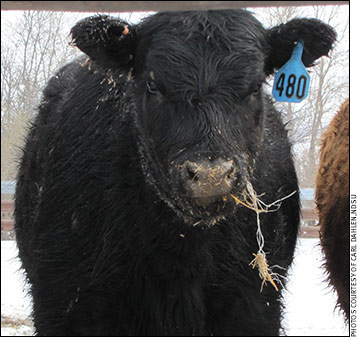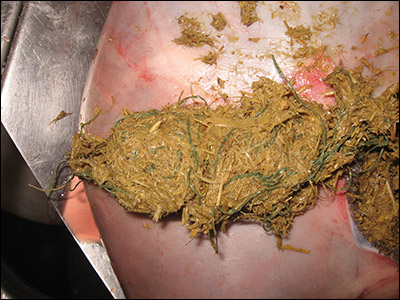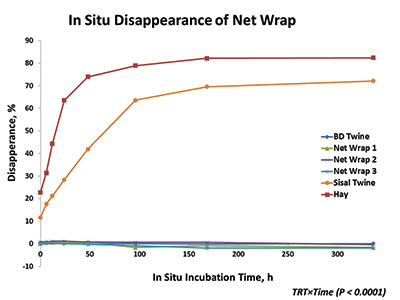Study Looks at
Ingested Net Wrap in Cattle
Net wrap: A handy tool for cattle producers, a source of bloat in cattle.
Sisal and plastic twines have been used for several years, but today, many hay producers are using net wrap on their hay bales. Some stockmen remove twines/net wrap prior to feeding, grinding/chopping or bale-grazing, while others leave them on due to time constraints or inability to pull the twines/wrap off frozen bales. Usually, cattle eat the hay or straw and leave the twines/wrap, which can be gathered later. In some instances, however, cattle have become fatally impacted after ingesting twines or net wrap. Net wrap seems to be the most hazardous of the two.

Accumulated net wrap in the rumen can create a blockage
and
reduce the animal’s intake, causing weight loss, Carl Dahlen says.
Some ranchers have had cows waste away to the point they
had
to be humanely destroyed. Later, net wrap was
found in their
rumen during necropsy.
Carl Dahlen, beef cattle specialist at North Dakota State University, became interested in this problem after seeing a case of acute bloat associated with ingestion of a large wad of net wrap. He decided to compare various materials to see how well they break down in the rumen.
Dahlen evaluated six types of material: sisal, biodegradable twine, three kinds of net wrap and hay (bromegrass). The hay was a control sample for comparison. Each material was cut into small pieces, and two grams of each sample was put into little nylon bags. Each bag was placed in the rumen of forage-fed Holstein steers.
“Rumen fluid could come into the bag and bacterial action could occur,” says Dahlen. After being in the rumen for various times (four days, seven days and 14 days), the bags were taken out and rinsed (to remove extra material and rumen fluid), drained and dried, then weighed.

Netwrap blockage like this would create lingering effects, such as impaction or weight loss, because the rumen is full and the animal can’t eat much. These cattle may also have diarrhea because only the fluid contents of the rumen can get past the blockage.
“After 14 days in the rumen, none of the three types of net wrap or the biodegradable twine samples diminished. Most of the hay sample was digested and gone, and more than 70% of the sisal twine disappeared over the 14-day period. Biodegradable twine breaks down in UV light, but there is no UV light in the rumen,” he says.
Accumulated net wrap in the rumen can create a blockage and reduce the animal’s intake, causing weight loss, he says. Some ranchers have had cows waste away to the point they had to be humanely destroyed. Later, net wrap was found in their rumen during necropsy.
Dahlen conducted a second research study using finishing steers that were fed net wrap. One group of steers was fed net wrap until harvest, while a second group was fed net wrap until 14 days before harvest.
“We wanted to see if the net wrap might go on through, or if this material would still be there after 14 days,” says Dahlen.
“The net wrap would come up with the other material, get chewed more, and the rumen is churning, pulling everything around during the digestive process. We wondered if this might clear it out of the system,” he explains.
At harvest, both steer sets’ rumens were examined. Dahlen found net wrap throughout the rumens of both groups.
“It could potentially create a blockage on the front end, which would lead to bloat (hindering ability to burp) or block the other end,” he says.

Blockage like this would create lingering effects, such as impaction or weight loss, because the rumen is full and the animal can’t eat much. These cattle may also have diarrhea because only the fluid contents of the rumen can get past the blockage.
“If cows have been eating net wrap pieces for several years — small pieces that won’t kill them — and these accumulate slowly over time, it may reduce feed efficiency. Part of their rumen is full of net wrap and will never be filled with hay,” says Dahlen.
Dahlen points out his experiments simulated the effects of ground-up bales with small pieces of net wrap. He emphasizes that net wrap left on bales creates a different ingestion situation in that cattle could ingest large pieces of net wrap, which might cause a quicker fatality.

Editor’s Note: Heather Smith Thomas is a freelance writer and cattlewoman from Salmon, Idaho.





